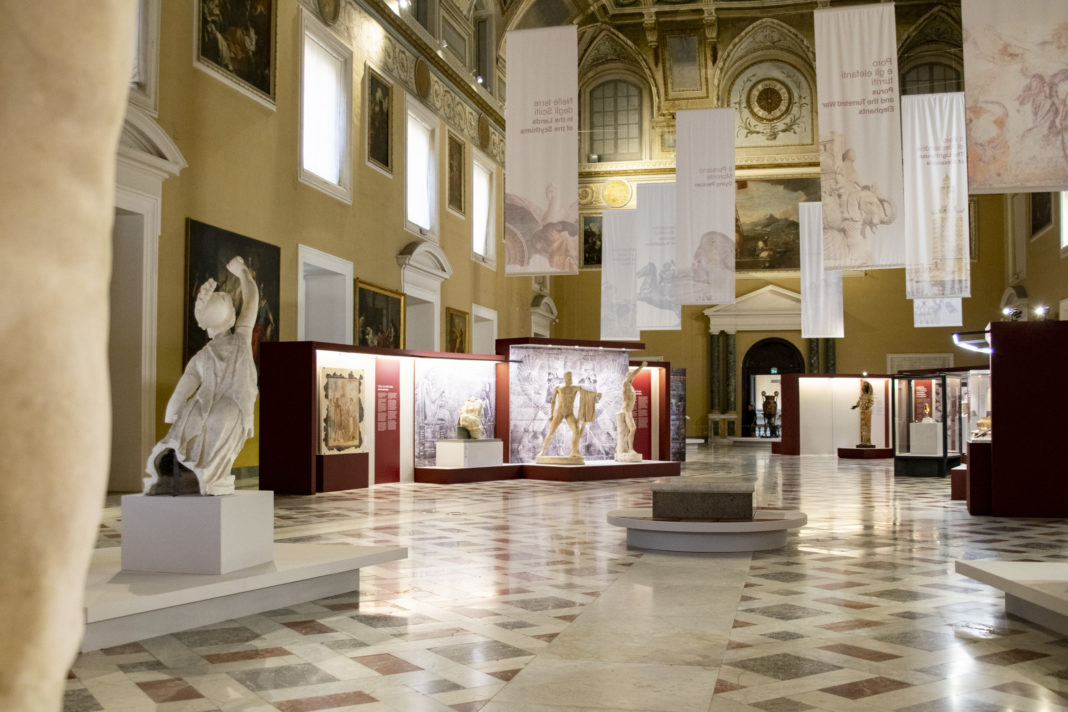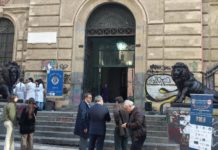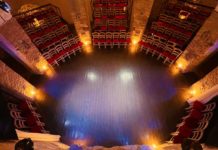“Alessandro Magno e l’Oriente”. Illumina il museo archeologico nazionale di Napoli con 170 opere da tutto il mondo che incontrano i capolavori del Mann da ieri fino al 28 agosto. L’allestimento è di Andrea Mandara.
L’apertura della mostra coincide con l’inizio della seconda fase esecutiva dell’epocale restauro del celebre mosaico di Alessandro, che sarà possibile seguire nei prossimi mesi grazie a un cantiere trasparente
(chiusura lavori prevista, marzo 2024).
Curata da Filippo Coarelli ed Eugenio Lo Sardo è dedicata alla straordinaria figura del condottiero e militare macedone (356 – 323a. C) aproprio nel luogo che più di ogni altro custodisce eccezionali e uniche testimonianze della sua vita e delle sue gesta.
In poco più di dieci anni, accompagnato dai suoi fedeli compagni,
divenne re dell’Asia e dell’Europa. E da uomo e da filosofo, allievo del sommo Aristotele, amò l’uno e l’altro continente, promuovendo, dopo la conquista, la pace e l’unione dei popoli a lui soggetti.
L’esposizione si sviluppa in 2 spazi: l’Atrio monumentale e il Salone della Meridiana, con riferimenti tematici nei tre giardini storici.
Sono esposte circa 170 opere provenienti da ogni angolo del mondo: dalla antica Persia al Gandhara.
Alle opere ospiti si aggiungono i numerosi reperti della collezione permanente: qui si conservano tre ritratti del Macedone e tra questi il più prezioso, il Mosaico della battaglia di Gaugamela, dove si ammira l’eroe in sella a Bucefalo, mentre si scaglia contro Dario sull’alto carro.
Questo mosaico, attualmente in restauro, (la riproduzione è nel Salone della Meridiana dove è ricostruito l’ambiente della casa del Fauno) secondo gli studiosi è una copia romana di un quadro del più noto pittore dell’antichità, Apelle.
Alessandro è stato re, filosofo, invincibile stratega e guerriero. Ha conosciuto meglio di ogni altro gli usi e i costumi dei popoli e delle genti di Europa e di Asia.
È lui stesso la guida che introduce il pubblico alla scoperta delle sue imprese e delle grandi civiltà del passato. Un eroe che, come un’impareggiabile pop star, ha indossato gli abiti del faraone, quelli di Zeus, di Eracle, di Dioniso, di Shah di Persia, di raja di Taxila e dell’India.
In mostra, lo stratega macedone lo troviamo su busti, gemme, sculture, tra cui il busto-erma del Museo del Louvre, copia romana da un originale di Lisippo.
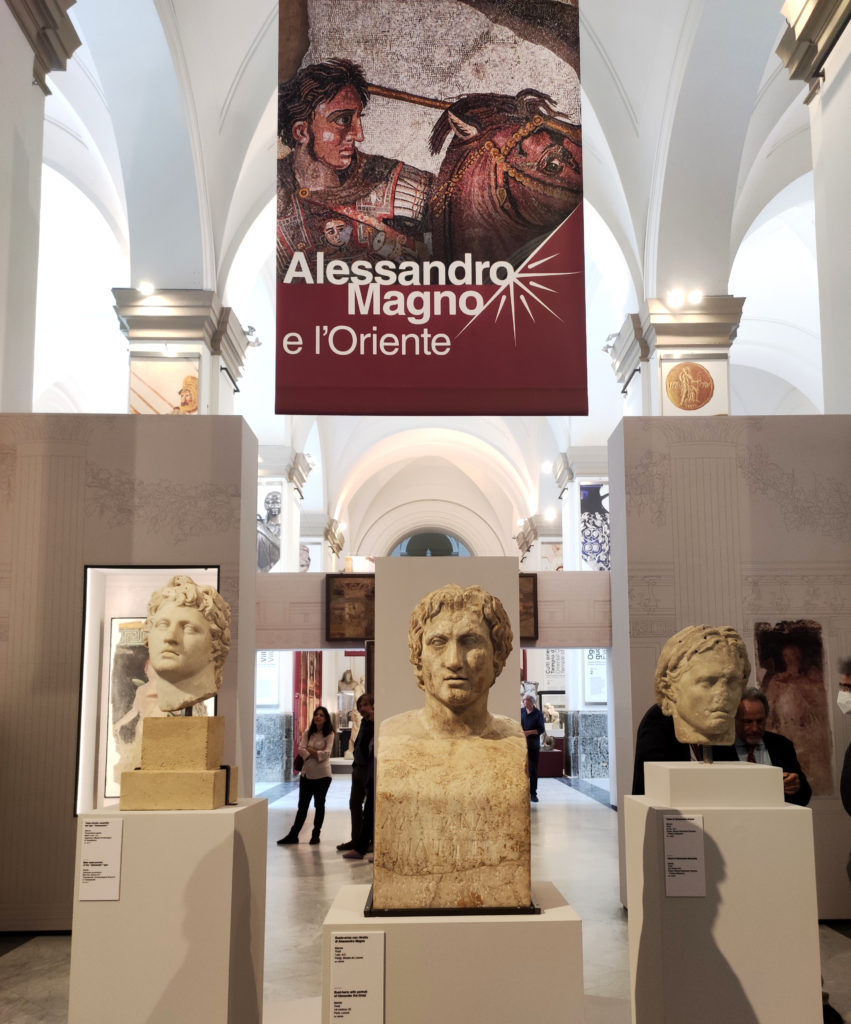
Si accede, poi, nelle segrete stanze dove il destino del re del mondo viene annunciato da una profetessa con un magico scudo alla madre Olimpiade e al padre Filippo II. Si è accolti da un enigmatico genio alato
(conservato al Louvre), un Cabiro che offre alla futura sposa la famosa collana di Armonia.
Il peristilio e la sala principale della famosa Villa di Fannius Synistor di Boscoreale, uno dei più grandi enigmi della storia dell’arte, sono per la prima volta interamente ricostruiti e spiegati.
Nel Salone della Meridiana, in esposizione ulteriori e rari manufatti, che raccontano maacedoni e persiani, tra cui lo straordinario Vaso dei Persiani, risalente alla seconda metà del IV sec. a.C., dove è rappresentato l’eterno conflitto, cantato da Omero e poi da Erodoto, tra Europa e Asia, tra Grecia e Persia.
Non potevano mancare i viaggi di conquista e di scoperta di Alessandro, e con il racconto delle trionfali battaglie di annessione. In questi spazi è ricomposto il gruppo di statue equestri marmoree, proveniente
dal santuario di Giunone Sospita a Lanuvio, conservato in parte al British Museum, in parte a Lanuvio.
In esposizione anche reperti che ricordano i più fedeli collaboratori di Alessandro Magno. Come Seleuco, guardia del corpo sempre al fianco di Alessandro in battaglia, raffigurato in un busto in bronzo dalla Villa dei Papiri.
Testimonianza preziosa è il grande mosaico pompeiano della Casa del Fauno, in cui si assiste all’impetuosa carica di Alessandro e alla fuga di Dario. A cavallo con la lancia ben ferma nella mano l’eroe avanza deciso contro il nemico travolgendo ogni persona, ogni difesa: ha i capelli rossicci
e ondulati, gli occhi grandi e scuri un po’ inclinati verso il basso, il naso forte e leggermente adunco e la bocca piccola e contratta nella foga dell’azione e per lo sforzo.
Intanto, stamattina, al Mann è stata inaugurata l’Area Green Bike del
Museo Archeologico Nazionale di Napoli, accesso all’Istituto dal lato piazza Cavour, ai piedi della scalinata: un angolo di 650mq delimitato da fioriere metalliche, con piante e fiori, dove è possibile ricaricare biciclette elettriche (e dispositivi elettronici) grazie ad una apposita colonnina. Installati anche poggia-bici, una fontanella realizzata recuperando un idrante di metà ‘900 e tre sedute in marmo antibivacco, ispirate
ai rocchi di colonna presenti anche all’interno della struttura museale.
L’intervento è stato finanziato da Volotea, la compagnia aerea low-cost delle piccole e medie città europee, con una sponsorizzazione di 50 mila euro, che testimonia l’impegno del vettore nella promozione della salvaguardia e valorizzazione del patrimonio artistico-culturale dei propri centri di scalo.
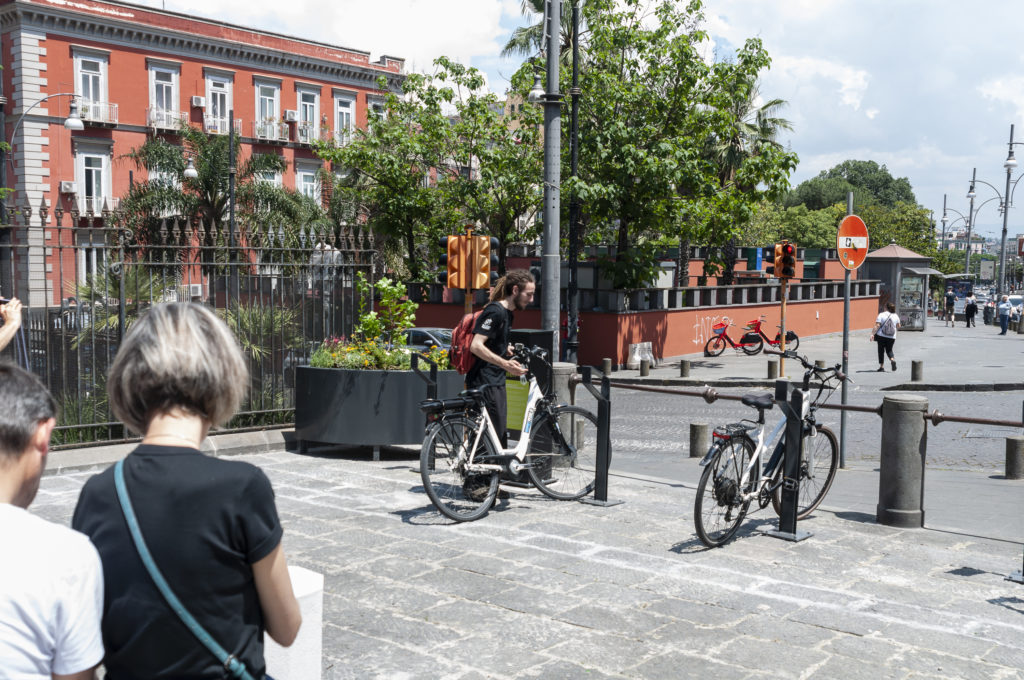
dedicata ad Alessandro Magno
Museo archeologico/ Alexander the Great and the Orient: 170 works from around the world to celebrate a pop star of antiquity
“Alexander the Great and the East.” Light up the National Archaeological Museum in Naples with 170 works from around the world meeting masterpieces at the Mann from yesterday until Aug. 28. The setting up is by Andrea Mandara.
The opening of the exhibition coincides with the start of the second executive phase of the epochal restoration of the famous Alexander mosaic, which will be possible to follow in the coming months thanks to a transparent construction site (expected work closure, March 2024).
Curated by Filippo Coarelli and Eugenio Lo Sardo, it is dedicated to the extraordinary figure of the Macedonian leader and soldier (356 – 323) apropriately in the place that more than any other holds exceptional and unique testimonies of his life and deeds.
In little more than ten years, accompanied by his faithful companions,
he became king of Asia and Europe. And as a man and a philosopher, a student of the supreme Aristotle, he loved both continents, promoting, after conquest, peace and union among the peoples subject to him.
The exhibition takes place in 2 spaces: the Monumental Atrium and the Sundial Hall, with thematic references in the three historic gardens.
About 170 works from all corners of the world are on display: from ancient Persia to Gandhara.
In addition to the guest works, there are numerous exhibits in the permanent collection: three portraits of the Macedonian are preserved here, and among them is the most valuable, the Mosaic of the Battle of Gaugamela, where the hero is admired riding Bucephalus as he hurls himself at Darius on the tall chariot.
This mosaic, currently under restoration, (the reproduction is in the Sundial Hall where the environment of the Faun’s house is reconstructed) according to scholars is a Roman copy of a painting by the most famous painter of antiquity, Apelles.
Alexander was a king, philosopher, invincible strategist and warrior. He knew better than any other person the customs and habits of the peoples and peoples of Europe and Asia.
He himself is the guide who introduces the audience to the discovery of his exploits and the great civilizations of the past. A hero who, like an incomparable pop star, wore the clothes of Pharaoh, those of Zeus, Heracles, Dionysus, Shah of Persia, raja of Taxila and India.
In the exhibition, we find the Macedonian strategist on busts, gems, sculptures, including the bust-erma in the Louvre Museum, a Roman copy from an original by Lysippus.
You then enter the secret chambers where the fate of the king of the world is announced by a prophetess with a magical shield to his mother Olympias and father Philip II. You are greeted by an enigmatic winged genie
(preserved in the Louvre), a Cabyrus who offers his bride-to-be the famous Harmony necklace.
The peristyle and main hall of the famous Villa of Fannius Synistor in Boscoreale, one of the greatest enigmas in art history, are for the first time fully reconstructed and explained.
In the Salone della Meridiana, additional and rare artifacts are on display, recounting Maacedonians and Persians, including the extraordinary Vase of the Persians, dating back to the second half of the 4th century B.C., where the eternal conflict, sung by Homer and later by Herodotus, between Europe and Asia, between Greece and Persia, is depicted.
Alexander’s voyages of conquest and discovery could not be missed, with the tale of triumphant annexation battles. In these spaces is reassembled the group of marble equestrian statues, from the sanctuary of Juno Sospita at Lanuvio, preserved partly in the British Museum, partly in Lanuvio.
Also on display are artifacts commemorating Alexander the Great’s most loyal associates. Such as Seleucus, a bodyguard always at Alexander’s side in battle, depicted in a bronze bust from the Villa of the Papyri.
Valuable evidence is the large Pompeian mosaic from the House of the Faun, in which we see Alexander’s impetuous charge and Darius’ fleeing. On horseback with his spear firmly in his hand, the hero advances determinedly against the enemy, overwhelming every person, every defense: his hair is reddish and wavy, his eyes large and dark somewhat slanted downward, his nose strong and slightly hooked, and his mouth small and contracted in the heat of action and from exertion.
Meanwhile, this morning, the Mann opened the Green Bike Area of the
National Archaeological Museum of Naples, accessing the Institute from the Piazza Cavour side, at the foot of the staircase: a 650-square-meter corner bordered by metal planters, with plants and flowers, where it is possible to recharge electric bicycles (and electronic devices) thanks to a special column.
Also installed are bike rests, a drinking fountain made by salvaging a mid-20th-century fire hydrant, and three anti-bivouac marble seats, inspired to the columnar rocchi also present inside the museum structure.
The intervention was financed by Volotea, the low-cost airline for small and medium-sized European cities, with a sponsorship of 50,000 euros, which testifies to the carrier’s commitment to promoting the preservation and enhancement of the artistic and cultural heritage of its stopover centers.


